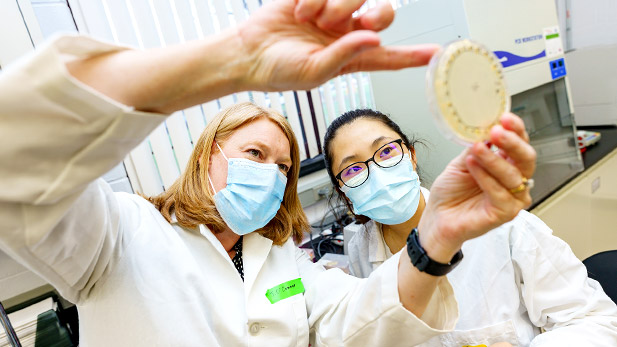Microbiology Students Search for Antibiotics in Soil Microorganisms on Rose-Hulman Campus

As part of the Tiny Earth project, students in Professor Jen O’Connor’s microbiology course are looking for new antibiotics in soil microorganisms on the Rose-Hulman campus.
This spring, students in Professor Jen O’Connor’s microbiology course will be studying beyond the classroom as they look for antibiotics in soil microorganisms on the Rose-Hulman campus. This project is part of Tiny Earth, an international effort addressing one of the most pressing global health challenges of the century: the diminishing supply of effective antibiotics.
“We're in a crisis where there are more bacteria, and different species are becoming resistant to antibiotics at a pretty fast rate,” says O’Connor. “Because of this, in the near future, we may not be able to treat things we have treated for many years.”
That’s where Tiny Earth is important. The project crowdsources undergraduate research to explore new potential antibiotics. O’Connor first learned of Tiny Earth’s mission after attending a conference several years ago with researchers from across the globe, including as far as Nigeria and the Philippines. While not every person who works with Tiny Earth is a microbiologist, they all share a common goal of isolating potential antibiotics.
Students in O’Connor’s microbiology course are given soil containers and charged with finding soil specimen from across campus. In addition to collecting soil on the main campus, this year students will have the option of exploring the Hulman Farm property to gather soil. Students then take their soil to the lab and test it for nutrients and bacteria, which is screened against safe relatives of ESKAPE pathogens, the most common antibiotic-resistant bacteria is hospitals. ESKAPE is an acronym and includes the following bacteria: Enterococcus faecium, Staphylococcus aureus, Klebsiella pneumoniae, Acinetobacter baumannii, Pseudomonas aeruginosa, and Enterobacter spp.
O’Connor has taught this microbiology class for several years. It’s comprised of mainly sophomore and juniors. However, it attracts several students from outside the biology major and those interested in the future of pharmaceuticals, including biochemistry, chemistry biomathematics and chemical engineering students.
While each undergraduate works individually to find and characterize antibiotics, O’Connor also groups them in teams to create a scientific poster and present it on campus as the culminating project. The data and research are also uploaded to the large Tiny Earth database that is available to other scholars. Researchers can then compare the data and see what has been found in other parts of the globe.
“We always find some antibiotic,” says O’Connor. “Whether or not it's new is not always known. But every student finds any antibiotic, at least one, if not many. … It’s a very hands-on course for the students to get an idea of real research and then hopefully it can contribute to the greater good.”